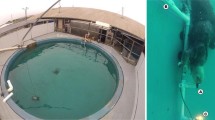Abstract.
Octavolateral sensory organs (auditory and lateral line organs) of cave salamander Proteus anguinus are highly differentiated. In the saccular macula of the inner ear the complex pattern of hair cell orientation and the large otoconial mass enable particle displacement direction detection. Additionally, the same organ, through air cavities within the body, enables detection of underwater sound pressure changes thus acting as a hearing organ. The cavities in the lungs and mouth of Proteus are a resonators that transmit underwater sound pressure to the inner ear. Behaviourally determined audiograms indicate hearing sensitivity of 60 dB (rel. 1 μPa) at frequencies between 1 and 10 kHz. The hearing frequency range was between 10 Hz and 10 kHz. The hearing sensitivities of depigmented Proteus and black Proteus were compared. The highest sensitivities of the depigmented animals (N=4) were at frequencies 1.3-1.7 kHz and it was 2 kHz in black animals (N=1). Excellent underwater hearing abilities of Proteus are sensory adaptations to cave habitat.
Similar content being viewed by others
Author information
Authors and Affiliations
Additional information
Published: January 2000
Rights and permissions
About this article
Cite this article
Bulog, B., Schlegel, P. Functional morphology of the inner ear and underwater audiograms of Proteus anguinus (Amphibia, Urodela). Pflügers Arch 439 (Suppl 1), r165–r167 (2000). https://doi.org/10.1007/s004240000132
Issue Date:
DOI: https://doi.org/10.1007/s004240000132




